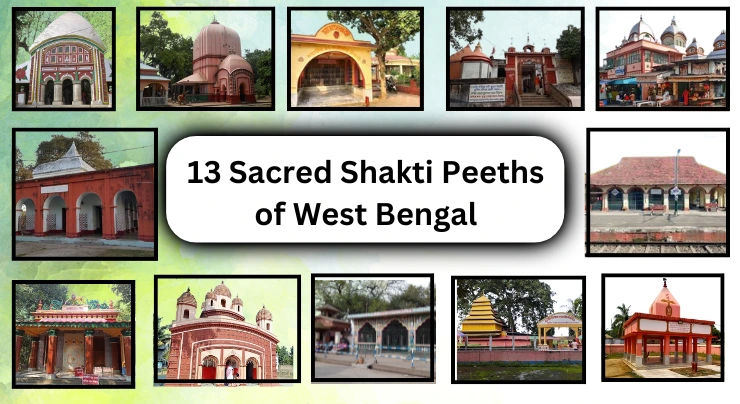13 Sacred Shakti Peeths of West Bengal
India is dotted with sacred sites known as Shakti Peeths. These are revered locations where, according to Hindu mythology, parts of the charred body of Goddess Sati, the consort of Lord Shiva, fell after he carried her body across the universe in grief. Each of the 51 Shakti Peeth is thus imbued with divine feminine energy, representing the potent and creative force of the universe.
Thank you for reading this post, don't forget to subscribe!Among the various states of India, West Bengal holds a particularly significant position, boasting a remarkable concentration of 13 shakti peeths of west bangal. These thirteen sites, scattered across the diverse landscapes of West Bengal, are not merely places of pilgrimage; they are vibrant centers of religious and cultural life, embodying the enduring faith and traditions of the region.
Each Shakti Peeth is unique, possessing its own distinct history, mythology, and rituals, while collectively they celebrate the diverse manifestations of the divine feminine, from nurturing mother to fierce protector. This article embarks on a journey to explore these thirteen sacred Shakti Peeths, delving into their legends, significance, and the unique characteristics that make each one a cherished destination for devotees seeking the blessings of the divine mother.
The 13 Sacred Shakti Peeths of West Bengal: A Journey of Divine Discovery
West Bengal’s thirteen Shakti Peeths are scattered across the state, each holding a unique significance and attracting devotees from far and wide. Below, we explore each of these sacred sites in detail:
-
Kalighat Kali Temple (Kolkata):
- Location: Kolkata
- Body Part: Right toes of Sati
- Shakti: Kalika
- Bhairava: Nakuleshwar
- Description: One of the most famous Shakti Peeths, Kalighat is dedicated to Kali, the fierce form of Shakti. The temple’s history is steeped in legend, and it’s a vibrant center of Tantric worship. The image of Kali is unique and powerful.
-
Tarapith Temple (Rampurhat):
- Location: Rampurhat, Birbhum district
- Body Part: Knee cap
- Shakti: Tara
- Bhairava: Akshobhya
- Description: Located in Rampurhat, Tarapith is renowned for its Tantric significance and the powerful deity Tara. Sati’s knee cap is believed to have fallen here. Associated with the saint Bamakhepa, the temple attracts devotees seeking spiritual enlightenment and fulfillment of desires. Known for its Tantric practices and the powerful deity Tara, this temple is associated with the famous Tantric saint Bamakhepa.
-
Bakreshwar Temple (Bakreshwar):
- Location: Bakreshwar, Birbhum district
- Body Part: Portion of the forehead
- Shakti: Mahishmardini
- Bhairava: Vakreshwar
- Description: Bakreshwar, in Birbhum, is known for its hot springs and the deity Mahishmardini. A portion of Sati’s forehead is said to have fallen here. The temple is a significant pilgrimage site, attracting devotees seeking healing and
-
Kireeteswari Temple (Kiritkona Village):
- Location: Kiritkona Village, Murshidabad district
- Body Part: Crown (Kireeta)
- Shakti: Kireeteswari
- Bhairava: Bhairava
- Description: Situated in Murshidabad, Kireeteswari is a historic temple where Sati’s crown (Kireeta) fell. Revered by devotees, this temple has connections to ancient kingdoms and embodies the rich cultural heritage of the region
-
Nalhati Temple (Nalhati):
- Location: Nalhati, Birbhum district
- Body Part: Tibia bone
- Shakti: Kalika
- Bhairava: Yogeesha
- Description: Nalhati, in Birbhum, houses Kalika, and Sati’s tibia bone is believed to have fallen here. Though less widely known, it is a significant Shakti Peeth, drawing devotees seeking the blessings of the divine feminine.
-
Bahula Temple (Ketugram):
- Location: Ketugram, Burdwan district
- Body Part: Left arm
- Shakti: Bahula
- Bhairava: Kshetrabala
- Description: Located in Ketugram, Burdwan, Bahula is where Sati’s left arm fell. Dedicated to the goddess Bahula, this rural temple offers a peaceful and serene atmosphere for devotees seeking spiritual solace.
-
Ujjani Temple (Guskara):
- Location: Guskara, Burdwan district
- Body Part: Right wrist
- Shakti: Mangalachandi
- Bhairava: Amarak
- Description: Dedicated to Mangalachandi, this temple is associated with prosperity and well-being. In Guskara, Burdwan, Ujjani is dedicated to Mangalachandi. Sati’s right wrist is believed to have fallen here. Associated with prosperity and well-being, the temple attracts devotees seeking blessings for a good life.
-
Tripureswari Temple (Sundarban):
- Location: Sundarban
- Body Part: Unknown
- Shakti: Tripureswari
- Bhairava: Unknown
- Description: Located in the Sundarbans, Tripureswari’s body part is unknown. This remote temple holds a mysterious aura. Its location in the Sundarbans adds to its mystique and spiritual significance.
-
Jwalaji Temple (Kalna):
- Location: Kalna, Burdwan district
- Body Part: Tongue
- Shakti: Jwalamukhi
- Bhairava: Unknown
- Description: Situated in Kalna, Burdwan, Jwalaji is dedicated to the fire goddess Jwalamukhi. Sati’s tongue is said to have fallen here. The temple symbolizes the fiery energy of the divine feminine.
-
Yogmaya Temple (Bodhhara):
- Location: Bodhhara, North 24 Parganas district
- Body Part: Forehead
- Shakti: Yogmaya
- Bhairava: Unknown
- Description: In Bodhhara, North 24 Parganas, Yogmaya is where Sati’s forehead fell. This relatively quiet temple offers a serene environment for contemplation and worship of the goddess Yogmaya.
-
Phullara Temple (Labhpur):
- Location: Labhpur, Birbhum district
- Body Part: Lower lip
- Shakti: Phullara
- Bhairava: Vishwesh
- Description: Phullara, in Labhpur, Birbhum, is where Sati’s lower lip fell. Dedicated to the goddess Phullara, this rural temple has a strong local following and embodies the folk traditions of the region.
-
Manasa Temple (Chandipur):
- Location: Chandipur, Howrah district
- Body Part: Left canine tooth
- Shakti: Manasa
- Bhairava: Unknown
- Description: Located in Chandipur, Howrah, Manasa is dedicated to the serpent goddess. Sati’s left canine tooth is believed to have fallen here. The temple reflects the reverence for nature and the divine feminine’s connection to it.
-
Ratnavali Temple (Khanakul):
- Location: Khanakul, Hooghly district
- Body Part: Right shoulder
- Shakti: Ratnavali
- Bhairava: Unknown
- Description: Situated in Khanakul, Hooghly, Ratnavali is where Sati’s right shoulder fell. This historic temple, with unique architectural features, is dedicated to the goddess Ratnavali and holds significant historical and religious importance.2. Tarapith Temple (Rampurhat):
13 Shakti Peeths in West Bengal
| Temple Name | Body Part (of Sati) | Location (District/Town) | Shakti Name | Bhairava Name |
|---|---|---|---|---|
| Kalighat Kali Temple | Right Toes | Kolkata | Kalika | Nakuleshwar |
| Tarapith Temple | Knee Cap | Rampurhat, Birbhum | Tara | Akshobhya |
| Bakreshwar Temple | Forehead Portion | Bakreshwar, Birbhum | Mahishmardini | Vakreshwar |
| Kireeteswari Temple | Crown (Kireeta) | Kiritkona, Murshidabad | Kireeteswari | Bhairava |
| Nalhati Temple | Tibia Bone | Nalhati, Birbhum | Kalika | Yogeesha |
| Bahula Temple | Left Arm | Ketugram, Burdwan | Bahula | Kshetrabala |
| Ujjani Temple | Right Wrist | Guskara, Burdwan | Mangalachandi | Amarak |
| Tripureswari Temple | Unknown | Sundarban | Tripureswari | Unknown |
| Jwalaji Temple | Tongue | Kalna, Burdwan | Jwalamukhi | Unknown |
| Yogmaya Temple | Forehead | Bodhhara, North 24 Parganas | Yogmaya | Unknown |
| Phullara Temple | Lower Lip | Labhpur, Birbhum | Phullara | Vishwesh |
| Manasa Temple | Left Canine Tooth | Chandipur, Howrah | Manasa | Unknown |
| Ratnavali Temple | Right Shoulder | Khanakul, Hooghly | Ratnavali | Unknown |
Significance and Cultural Impact of West Bengal’s Shakti Peeths
The thirteen Shakti Peeths of West Bengal are not merely scattered shrines; they form an integral part of the state’s religious and cultural landscape. They represent the enduring presence of the divine feminine in the region, shaping traditions, beliefs, and practices for centuries. These sites are more than just places of worship; they are vibrant centers of community life, where festivals are celebrated with great fervor and local traditions are kept alive.
The worship of Shakti in West Bengal is deeply ingrained in the Bengali psyche. The goddess is revered in her various forms, from the benevolent mother to the fierce protector, reflecting the multifaceted nature of the divine feminine. Each Shakti Peeth has its own unique rituals and festivals, often connected to local folklore and agricultural cycles. These celebrations are not just religious events; they are social gatherings that bring communities together, reinforcing social bonds and cultural identity.
The influence of these Shakti Peeths extends beyond religious practices. They have also played a significant role in shaping the artistic and literary traditions of Bengal. The images and stories of the goddesses are often depicted in art forms like painting, sculpture, and theatre. Many literary works, both classical and modern, draw inspiration from the myths and legends associated with these sacred sites. The devotional music of Bengal, including genres like Shyama Sangeet (songs dedicated to Kali), often celebrates the glories of the goddesses worshipped at these Shakti Peeths.
The Shakti Peeths also contribute to the local economy. They attract pilgrims and tourists from all over the world, generating revenue for local communities. The sale of religious items, souvenirs, and local handicrafts provides livelihood opportunities for many. The temples themselves often engage in charitable activities, further contributing to the welfare of the community.
In essence, the thirteen Shakti Peeths are not just religious sites; they are living embodiments of West Bengal’s cultural heritage. They are places where faith, tradition, art, and community intersect, creating a rich tapestry of spiritual and cultural significance.
Read More:





